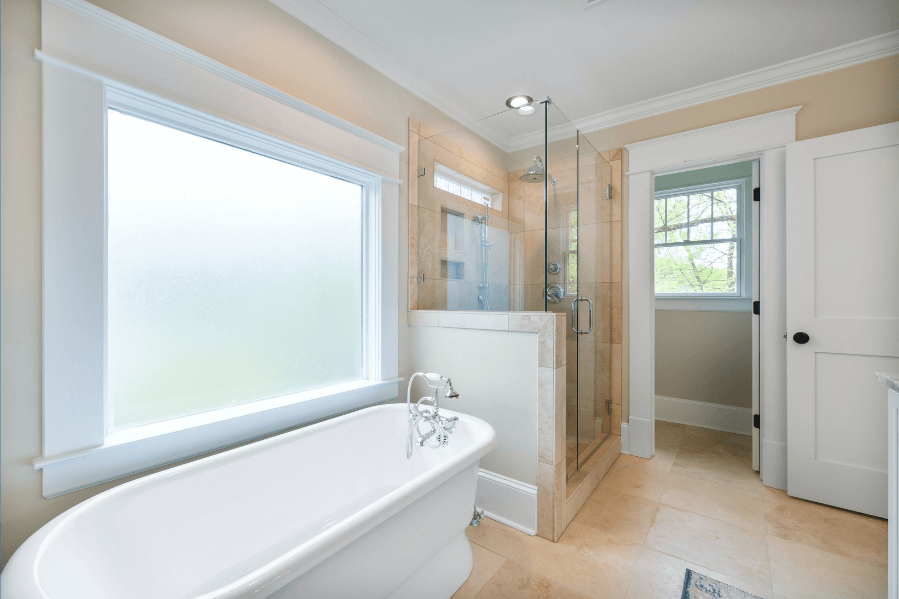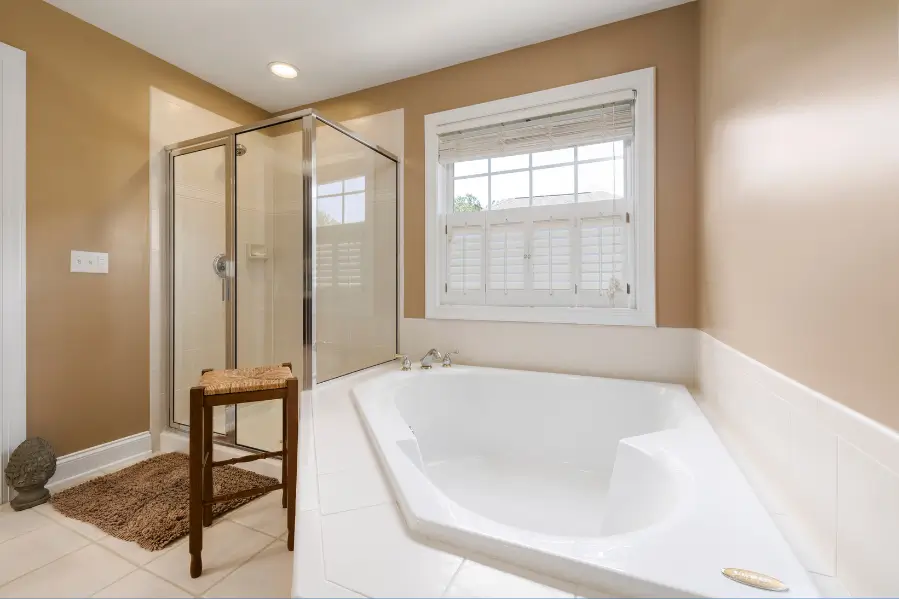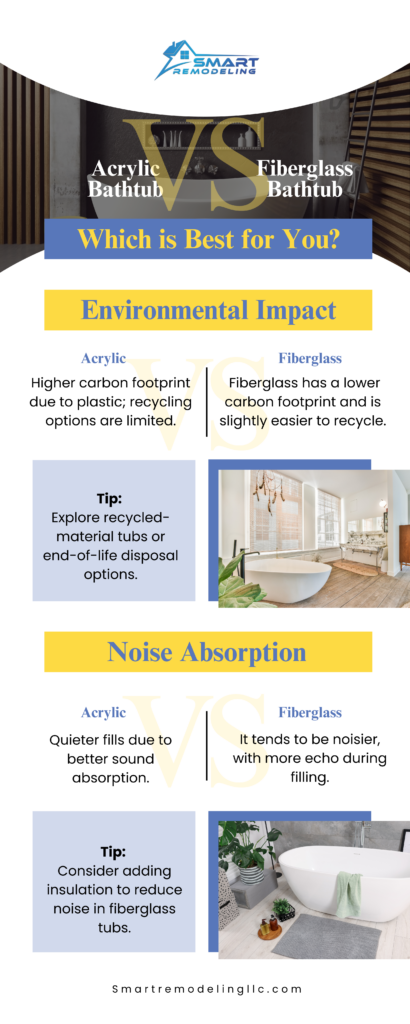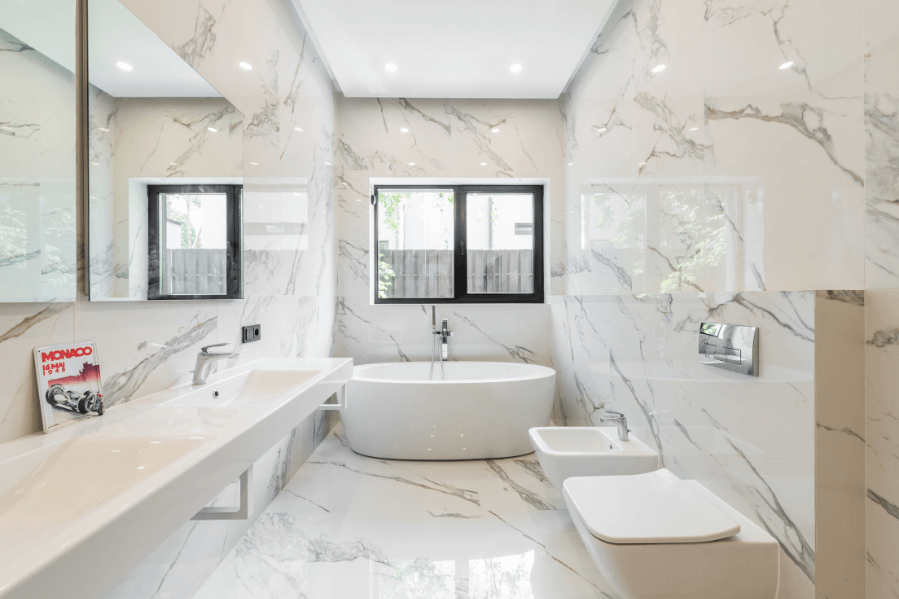The bathtub is not just an installation; it is part of the bathroom where functionality blends with a place of rest. The material with which the bathtub is made influences its appearance, feel, durability, and long-term maintenance.
Generally, two materials have dominated the market as being the most sought-after in the making of bathtubs—Acrylic and fiberglass. Both provide different advantages and disadvantages, and the final choice is really up to personal preference, need, and budget.
Knowing the differences between these two materials will make deciding which bathtub to put in your home easier. Let’s explore each in detail so you can make the best possible decision for your needs.
What are Acrylic Bathtubs?
Acrylic bathtubs are molded from an entire sheet of melted plastic, molded into a form, and reinforced with fiberglass, thus giving the bathtub the needed stability and strength.
The result produces a rigid, impervious tub layer by layer, which would not absorb any water and is very resistant to breakage. Most homeowners do it because acrylic is durable, long-lasting, and feels luxurious.
What are Fiberglass Bathtubs?
Fiberglass bathtubs are made by gluing fine glass fibers and resins together in the shape of a bathtub. Resin is applied over the molded tub to make it resistant to the elements and foster longevity.
The result of this process is an extremely lightweight, inexpensive tub-due to this reason; fiberglass has become a favorite for budget-conscious homeowners. To budget-conscious homebuyers, fiberglass is attractive not only because it is cheaper but also lighter.
What are the Similarities between Acrylic Bathtubs and Fiberglass Bathtubs?

Acrylic bathtubs and fiberglass bathtubs exhibit features that render them as popular contemporary bathroom installations. Some of the key similarities that occur between the two include:
1. Lightweight and Easy Installation
While acrylic tends to be heavier than fiberglass, they are much lighter compared to other types of materials such as cast-iron or stone. They are easily installed at any bathroom layout, including second-floor locations, and are usually easier to maneuver and place during installation.
2. Comparatively Affordable
Acrylic and fiberglass tubs are much cheaper than other bathtub materials, such as cast iron, copper, or stone. Because of lower production and installation costs, it can be afforded by a wide range of budgets.
3. Available in Shapes and Sizes
Both materials can be molded into various sizes, shapes, and fashions, though acrylic can be supplied with a lot more designs than fiberglass can offer, especially when it comes to standard tub shapes and sizes.
4. Low Maintenance Needs
Both tubs require low maintenance and only require periodic cleaning to retain their best state. Simple cleaning routines involving mild, non-abrasive cleaners are generally enough to keep them looking good.
What’s the Difference Between Acrylic and Fiberglass Bathtubs?

Even if they are somewhat similar, the acrylic and fiberglass bathtubs do differ in many ways that may determine your choice. Here’s a comprehensive comparison with key factors:
1. Durability
Acrylic: Acrylic bathtubs are generally stronger and have fewer pores compared to fiberglass. It is less susceptible to scratches, chips, and cracks, and it will easily hold up to most daily stress.
Fiberglass: Fiberglass is fragile. This material tends to crack, get scratched, and degrade faster than acrylic. The porosity it possesses makes it more susceptible to water absorption, which in turn may lead to stain formation and the weakening of its structural integrity in the distant future.
2. Heat Retention
Acrylic: Acrylic tubs retain heat very well because they have a thick structure, which enables you to stay in the bathtub for longer periods without the water cooling down fast.
Fiberglass: Fiberglass tubs lose heat faster, owing to their wall being thinner, something that might not bode well for those that love long stays in the bathtub.
3. Cost
Acrylic: Cost is an important factor that you must not ignore. Acrylic tubs are more expensive primarily due to their durability and the fact that they take more time to produce. But its lifespan can offset the cost of money being stretched.
Fiberglass: Fiberglass tubs are less expensive and can be easier on a wallet. This is an excellent option for homeowners whose wallets are sensitive or who want temporary changes in a bathroom.
4. Weight
Acrylic: The acrylic tub is heavier than fiberglass. Therefore it may need additional framing for bigger sizes or freestanding models during installing.
Fiberglass: Bathtubs made of fiberglass are lighter than both of the others, thus simpler to install and excellent for those second-floor bathrooms or other situations where you cannot use floor support.
5. Design and Customization
Acrylic: Acrylic can be molded to a greater extent at the manufacturing end, thus enabling greater design variety in shape, size, color, and even design from the surface.
Fiberglass: Fiberglass bathtubs offer less design flexibility and usually come in standard shapes with base colors such as white or beige. Fiberglass bathtubs may also experience fading of their colors due to sunlight exposure or chemicals applied during cleaning.
6. Maintenance and Cleaning
Acrylic: The smooth and nonporous surface of the acrylic tub makes it less prone to staining and easier to clean. They will remain looking good if cleaned through the regular routine with mild soap and water.
Fiberglass: Fiberglass tubs require more frequent cleaning in order not to stain. The porous nature of the material absorbs water easily and other dirt particles when left unclean for an extensive period.
7. Environmental Impact
Acrylic: The acrylic manufacturing process contains more plastic and creates a higher carbon footprint than fiberglass, for those concerned homeowners from the ecologist’s perspective.
Fiberglass: Fiberglass has slightly smaller positive effects on the environment as well due to its manufacturing process; however, it also is derived from fossil fuel-based sources. Recycling capabilities are also not great for either option.

Revitalize Your Bathroom with Smart Bathtub Service from Smart Remodeling LLC
Smart Remodeling LLC will bring wide professional facilities to transform your bathroom into a functional and aesthetically pleasing space with durable, high-quality bathtub options.
With specializations in acrylic and fiberglass bathtub installations, expert guidance in selection for the right tub style and material based on your needs in terms of long-lasting durability in acrylic tubs or light and budget-friendly fiberglass material can be made possible.
With years of experience, Smart Remodeling LLC promises to offer reliable and skilled craftsmanship on all its projects. They cater to clients in the Greater Houston area, such as Pearland, Katy, Sugar Land, and many more territories. For consultations about bathtub services, you may call them at (832) 800-8889 to see various bathroom remodeling options with an appointment request with their team.
Conclusion
The final decision between acrylic and fiberglass bathtub will primarily depend on your specific needs and budget with an additional consideration towards the style you opt for. Both have unique strengths, and by considering the above similarities and differences, you can make a bathtub choice that fits your lifestyle, bathroom design, and budget.
FAQs
1. How long do acrylic and fiberglass bathtubs last?
Acrylic bathtubs usually last between 10 to 15 years or more if taken good care of, while a fiberglass bath would last between 10 to 12 years. Fiberglass wears out faster because it is porous; pores in it after many years may cause cracks and discoloration.
2. Are fiberglass bathtubs any easier to install?
Yes, fiberglass bathtubs are generally less heavy than acrylic tubs and thus easier to put in. They would also work well for second-floor baths or older homes where new structural support might be too expensive.
3. Can scratches or chips in an acrylic or fiberglass bathtub be repaired?
For example, most small scratches on both acrylic and fiberglass bathtubs can be erased or repaired by using a professional repair kit. More severe chips or cracks demand much more professional repair services, especially in fiberglass tubs where the damage spreads instantly.






